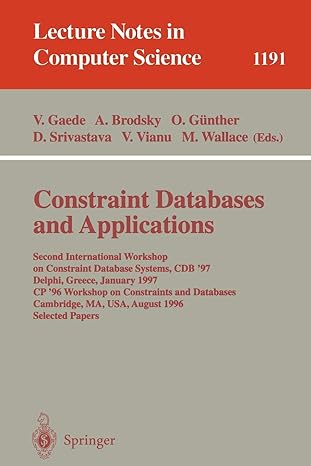Question
note description: [ A vertex has an item in the generic parameter, as well as incoming and outgoing edges: item: G outgoing: LIST[EDGE[G]] incoming: LIST[EDGE[G]]
note description: "[ A vertex has an item in the generic parameter, as well as incoming and outgoing edges: item: G outgoing: LIST[EDGE[G]] incoming: LIST[EDGE[G]] outgoing_sorted: ARRAY[EDGE[G]] outgoing_sorted is an array of edges sorted based on comparable items in destination vertices. This allows for a unique ordering as in breadth first searches etc. ]" note_to_student: "[ Only modify features that have a `Todo` comment inside of them. You must also write the postcondition for command `remove_edge`.
]"
class VERTEX[G -> COMPARABLE] inherit ANY redefine is_equal, out end DEBUG_OUTPUT redefine is_equal, out end COMPARABLE redefine is_equal, out end create make feature {NONE} -- Initialization make(a_item: G) -- Initialization for `Current'. do create {LINKED_LIST[EDGE[G]]}outgoing.make outgoing.compare_objects create {LINKED_LIST[EDGE[G]]}incoming.make incoming.compare_objects item := a_item ensure item_set: item ~ a_item empty_edges: outgoing.is_empty and incoming.is_empty end feature -- Comparable is_less alias "<" (other: like Current): BOOLEAN -- Is current object less than `other'? do Result := item < other.item end is_equal(other: like Current): BOOLEAN do Result := item ~ other.item end feature -- basic queries item: G outgoing: LIST[EDGE[G]] -- outging edges incoming: LIST[EDGE[G]] -- incoming edges feature -- derived queries outgoing_sorted: ARRAY[EDGE[G]] -- Return outgoing edges as a sorted array -- (based on destination vertices of edges). do -- Todo: complete implementation create Result.make_empty -- this line is for compilation purposes ensure -- i 1 .. (Result.count - 1) : Result[i].destination Result[i + 1].destination sorted: across 1 |..| (Result.count - 1) as l_i all Result[l_i.item].destination <= Result[l_i.item + 1].destination end end outgoing_edge_count: INTEGER -- number of outgoing edges do -- Todo: complete implementation ensure outgoing_edge_count: Result = outgoing.count end incoming_edge_count: INTEGER -- number of incoming edges do -- Todo: complete implementation ensure incoming_edge_count: Result = incoming.count end edge_count: INTEGER -- number of incoming and outgoing edges do -- Todo: complete implementation ensure correct_count: Result = incoming_edge_count + outgoing_edge_count end has_outgoing_edge(a_edge: EDGE[G]): BOOLEAN -- `Current` has `a_edge` as an outgoing edge do -- Todo: complete implementation ensure Result = outgoing.has (a_edge) end has_incoming_edge(a_edge: EDGE[G]): BOOLEAN -- `Current` has `a_edge` as an incoming edge do -- Todo: complete implementation ensure Result = incoming.has (a_edge) end feature -- commands add_edge(a_edge: EDGE[G]) require edge_contains_current: a_edge.source ~ Current or a_edge.destination ~ Current new_edge: not (has_incoming_edge (a_edge) or has_outgoing_edge (a_edge)) do -- Todo: complete implementation ensure a_edge.destination ~ Current implies incoming.count = old incoming.count + 1 a_edge.source ~ Current implies outgoing.count = old outgoing.count + 1 a_edge.destination ~ Current implies incoming.has (a_edge) a_edge.source ~ Current implies outgoing.has (a_edge) -- incomplete, to add! end remove_edge(a_edge: EDGE[G]) require a_edge.source ~ Current or a_edge.destination ~ Current do -- Todo: complete implementation ensure -- To do. end feature -- out out: STRING -- Return string representation of current vertex do Result := item.out + ":" across outgoing_sorted as l_edge loop Result := Result + l_edge.item.debug_output +"," end Result.remove (Result.count) end debug_output: STRING -- Return string representation of current vertex in debugger do Result := item.out + ":" across outgoing_sorted as l_edge loop Result := Result + l_edge.item.destination.item.out +"," end Result.remove (Result.count) end invariant outgoing_edges_start_with_current: across outgoing as l_edge all l_edge.item.source ~ Current end incoming_edges_end_with_current: across incoming as l_edge all l_edge.item.destination ~ Current end object_comparison: outgoing.object_comparison and incoming.object_comparison end
Step by Step Solution
There are 3 Steps involved in it
Step: 1

Get Instant Access to Expert-Tailored Solutions
See step-by-step solutions with expert insights and AI powered tools for academic success
Step: 2

Step: 3

Ace Your Homework with AI
Get the answers you need in no time with our AI-driven, step-by-step assistance
Get Started


